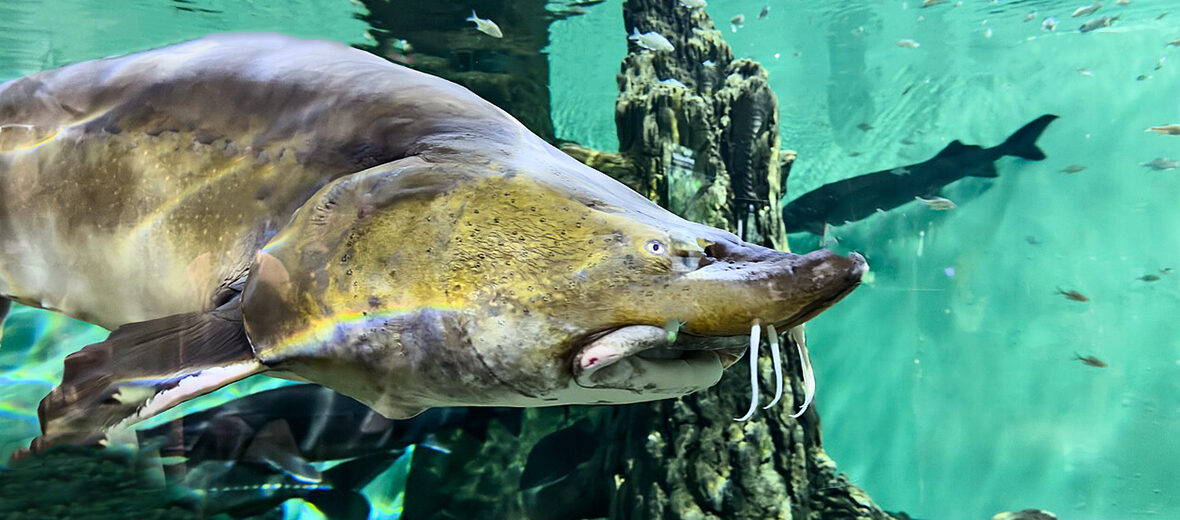
The kaluga sturgeon, aka river beluga, is the 2nd largest sturgeon after the beluga sturgeon. These giants can be found in the Amur River basin from Russia to China and near Hokkaido in Japan. These giants face the threats of overfishing and over harvesting of their roe (eggs); habitat loss and destruction at the hands of dams; and invasive species, and with them predation and disease. The IUCN lists these magnificent fish as Critically Endangered. Their population trend is listed as decreasing.
First the Stats…
Scientific name: Sinosturio dauricus
Weight: Up to 2,205+ lbs.
Length: Up to 18+ feet
Lifespan: Up to 55 years
Now on to the Facts!
1.) These fish have 5 major rows of dermal scutes.
2.) Being semi-anadromous, these fish spend part of their life in saltwater and part in freshwater.
3.) They have been hunted to near extinction for their valuable roe. Despite near constant anti-poaching patrols, poachers still find a way to catch these fish. In Russia, illegally fishing for kaluga anywhere on the Amur River is a felony punishable by law. Penalties can range from fines to imprisonment.
4.) Kalugas are 1 of the 4 known species of sturgeons to exist in the Amur river, which is 1 of the largest rivers in East Asia.
5.) While overfishing and over harvesting of their roe is the major cause of their general demise, environmental factors like warming water temperatures also pose a risk of fungus over free embryos and could be a cause of death.
But wait, there’s more on the kaluga sturgeon!
6.) Pike, carp, herring, chum, salmon, along with many other fish or shellfish are all on the menu, and they are known to eat anything that can fit into their mouths.
7.) Eggs hatch in up to 12.3 days and the parents play no part in protecting or rearing their young.
Did you know…?
There have been reports of kaluga toppling fishing boats and drowning fishermen, as these fish are known to be rather aggressive.
8.) Upon hatching, the fry can survive for up to 9 days on their yolk sac. After that they are required to hunt or perish.
9.) Juveniles prey on zooplankton, insects, and shrimp.
10.) They are carried by the current to the sea, where they remain for up to 14 years. Then they return to their freshwater birthplace to breed.
But wait, there’s still more on the kaluga sturgeon!
11.) Ever since the 1900s, these critters have been poached at an incredible rate. After World War II, in 1948, 67 tons of Kaluga were caught. This has increased to over 500 tons annually.
12.) From 1957 – 2008 an estimated 117 tons of sturgeon Caviar was collected!
13.) The Convention on International Trade in Endangered Species of Wild Fauna and Flora (CITES) has an international agreement signed by 180 nations that is designed to ensure that international trade in animals and plants does not threaten their survival in the wild.
14.) In addition, national laws have been passed to protect the Kaluga sturgeon. Commercial sturgeon fishing was strictly prohibited in the Soviet Union during the years 1923 – 1930, 1958 – 1976, and from 1984 to the present.
Now a Short Kaluga Sturgeon Video!
This video talks about sturgeons in general.
Be sure to share & comment below! Also, check out the Critter Science YouTube channel. Videos added regularly!

Want to suggest a critter for me to write about? Let me know here.
Some source material acquired from: Wikipedia & IUCN
Photo credit: Vyacheslav Bukharov



